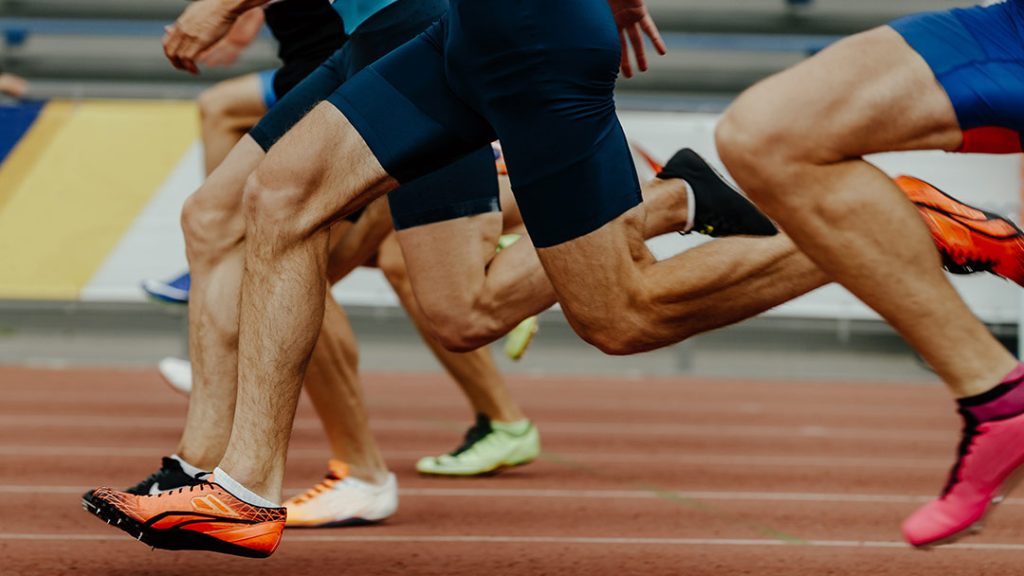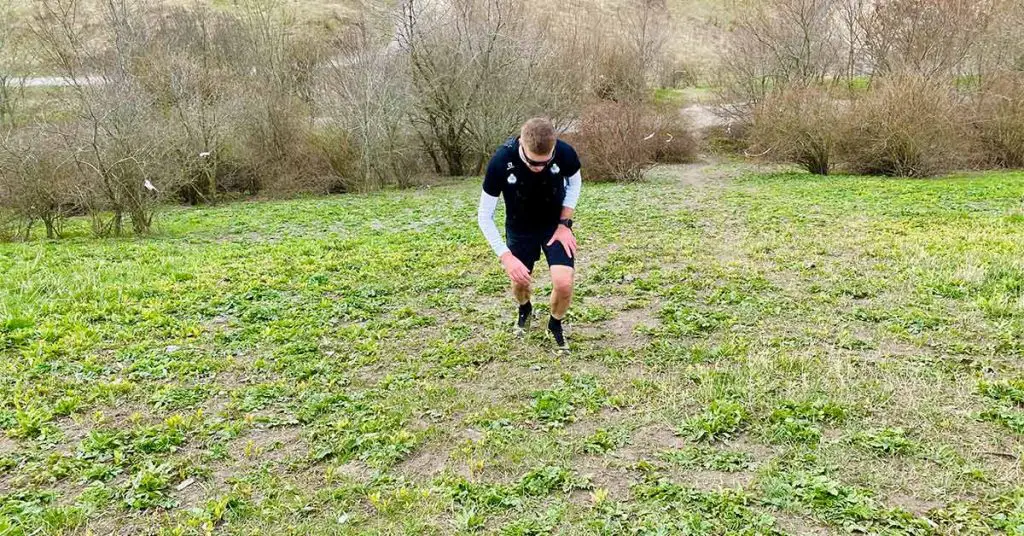Estimated read time: 9 minutes.
Many people have been asking for the average human sprint speed. Today we take a look at the average running speed of a human being and other helpful information.
For the records, an average person’s estimated top speed is 15 miles per hour. Usain Bolt is the only athlete to have gone beyond the limits of sprinting at 27.8 miles per hour, making him the fastest runner of our time. In fact, Usain’s running pace was much faster than the average car’s speed in California.
This comprehensive guide covers everything you should know about the average human running speed, the best exercises for reaching maximum velocity, the best running shoes, and much more.
How to Determine the Average Human Running Speed
You probably are asking yourself how the average athlete’s running speed is determined. In this section, we’ve shared the key factors we consider to determine human speed:
Fitness Level
To be considered the fastest human, physical and mental fitness is critical. The best runners hit the gym and maintain their training programs. A disciplined runner provides the best statistics for determining the average speeds.
Human Body Size
The body size of an athlete plays a big role in the overall running performance. From the collected data, top speed runners at the Olympic level tend to have low body fat, and runners at the high school level tend to have normal body fat. Additionally, height is vital when calculating the running pace of an average human athlete. Short athletes do well in sprints, while tall people are good at long-distance running.
Covered Distance
The best distance when determining average speed is a 100-meter race. Elite athletes are able to achieve top speeds in short bursts because they have strong legs. Some people are able to perform excellently in short runs, and others do well in long-distance runs.
Age Range
Many athletes start running in their late teen years. This is the age when male and female runners’ performances start to showcase. The age limit for active running varies depending on one’s capabilities. However, the running speeds decrease in most humans when they hit 70 years. The best running speed data is acquired from the young and medium age groups.
The following data were collected from 14 different groups of runners with varying top speeds in 2022.
The results are as follows:
Group #1: High School Male Sprinters
2022 Average 100-meter time: 10.21 seconds
Group #2: High School Female Sprinters
2022 Average 100-meter time: 11.396 seconds
Group #3: College Male Sprinters
2022 Average 100-meter time: 9.968 seconds
Group #4: College Female Sprinters
2022 Average 100-meter time: 10.94 seconds
Group #5: Olympic Male Sprinters
2022 Average 100-meter time: 9.688 seconds
Group #6: Olympic Female Sprinters
2022 Average 100-meter time: 10.607 seconds
Group #7: 40 to 49 Male Sprinters
Average 100-meter time: 11.26 seconds
Group #8: 40 to 49 Female Sprinters
Average 100-meter time: 12.77 seconds
Group #9: 50 to 59 Male Sprinters
Average 100-meter time: 11.88 seconds
Group #10: 50 to 59 Female Sprinters
Average 100-meter time: 13.44 seconds
Group #11: 60 to 69 Male Sprinters
1Average 100-meter time: 12.76 seconds
Group #12: 60 to 69 Female Sprinters
Average 100-meter time: 14.70 seconds
Group #13: 70 to 79 Male Sprinters
Average 100-meter time: 14.34
Group #14: 70 to 79 Female Sprinters
Average 100-meter time: 17.61 seconds
In summary, the average male running speed was determined to be 19.52 miles per hour and 17.12 miles per hour for female runners.
Factors that Determine Human Running Pace
Several factors may influence the average running pace in human beings. Overall, the biological sex of a person tells more about their running speeds. Male runners have more muscle mass and less body fat, which enables them to be faster than females.
The following are the general factors that affect an average runner:
Body Weight
Your body weight can affect your running performance significantly. The heavier you are, the more energy you need to propel your body. The difficulty of running increases based on the weight you’re subjecting on your legs. Additionally, your body weight affects the oxygen intake levels and thus your running pace. This is why lean people run a bit faster.
Running Gear
Another thing that can affect running speed is what you wear. Lightweight clothing is recommended for optimum running performance because they are weather resistant and they fit quite well on the body.
In addition, your running shoes have a significant role in the runner’s speed. The best running shoes must support and protect your feet from any injuries. Also, you should choose cushioned running socks to enhance your safety.
Strength and Endurance
How much strength do you have, and how much can you endure? A good sprinter must be physically fit and strong to enhance performance. The more power your legs have, the faster you can sprint. Regular exercise and proper training can improve your strength and endurance.
Terrain and Weather Conditions
Your running pace can be affected by the terrain of the race course and external weather conditions. Running on high terrains requires much energy and effort. This can exhaust your muscles if you don’t prepare for it. Also, external weather, like heavy rain and extreme cold or hot conditions, affects your body and running speed.
Gender and Age
As far as top speed is involved, men run faster than women. This is a biological condition that can not be edited. Nevertheless, many female sprinters have shown the world how fast they can run by setting outstanding records.
Additionally, a person’s age will determine how fast they can run at top speed. The best age group for most athletes is in the early twenties and thirties. The older you get, the weaker your muscles become, and therefore the slower you run.
Agility and Technique
To join the elite athlete’s group, you must be agile. Agility is the ability to adjust directions by speeding up and slowing down when needed. Balance and coordination are key factors that determine how agile a runner is. In addition, the technique you use in the race can influence your speed. You must understand your stride length and biomechanics to enhance your speed.
Comparing the Average Human Runners to Land Animals
Modern humans are striving to become faster runners than other animals. However, it’s quite impossible to outrun some animals, such as the Cheetah.
In the list below, we have compared different animals, and the fastest human is none other than Usain Bolt.
Animal Top Speed Usain Bolt Top Speed
Cheetah 70 mph 27.8 mph
Antelope 61 mph 27.8 mph
Lion 50 mph 27.8 mph
Wildebeest 50 mph 27.8 mph
Kangaroo 44 mph 27.8 mph
It’s clear from the chart above that even the fastest human cannot match the speed of these animals.
Secrets to Enhance Human Running Speed
There are many things you can do to increase your average sprinting speed. Even though implementing all these elements at once is impossible, you can adjust your daily routine to incorporate them.
Therefore, this is what you can do to increase the average pace:
Boost your Strength
Every time you run, your whole body depends on the strength of your two legs. People with strong muscles produce more power, and they tend to run faster. The best training exercise to improve your stamina are tempo runs, trail running, sprints, and intervals.
Maintain Average Weight
Having excess weight will definitely slow down your running speed. All elite athletes understand the value of having a healthy weight. Overall, it is recommended that a runner’s height and health must be proportional. All these are determined by what you put on your diet. To maintain your body weight, cut off alcohol, reduce sugar intake, consider white meat, and more.
Stretch and Rest Well
It is recommended to start by stretching your body muscles before running. You can do different stretching exercises, including standing squad, calf stretch, and lunge with a side bend. It is equally important to massage your sore points after every run.
Besides stretching, every runner needs to take enough rest. This helps your body recover and prepare for the next run or training.
Go for Breathing Exercises
The body of an average runner requires sufficient oxygen supply, especially when in motion. This is why you need to train yourself to balance your breathing pattern. The way you are supposed to breathe when running a sprint is different from when you are at a walking speed. Many experts recommend a rhythmic 3 to 2 breathing pattern that balances between foot and stroke.
Monitor your Hydration Status
Hydration is very important when running as your body releases 20x more heat than normal. This increases respiratory levels that can lead to dehydration if not well balanced. Dehydration causes cramps and headaches that can affect your overall performance.
What is the Maximum Speed a Human Can Run?
As earlier mentioned, the fastest human speed is 27.33 miles per hour. This is a world record time that was set back in 2009. Usain Bolt ran and completed a 100-meter race in 9.76 seconds to beat other world records to become the fastest man.
Under the female category, Florence Griffith-Joyner holds the world record as the fastest female runner.
Though Usain Bolt has a record as the fastest man, scientists say that an average man can run at a top speed of 40 miles per hour. However, these are computer-generated statistics that may vary with time.
Recommended Sprint Speed Workouts
Looking for the best workouts to increase your sprinting pace? Don’t worry; we have you covered. Like any other sport, sprint training is intense and requires discipline and focus. If you want to become the fastest runner, these are the workouts you must include in your training program. You should understand that we have specialized training for short and long sprints.
Short Sprint Workouts
Most people in short sprints like 100-meter races must emphasize acceleration in their routine workouts. Also, they need to focus on strength building and speed training. Since the races are short, many athletes are able to accelerate fast to reach the top speed and maintain it to the end.
Long Sprint Workouts
Long sprints involve covering between 200 meters and 400 meters. Therefore, these runners need more endurance than short sprinters. The longer the distance, the more energy you need to propel your body. Long sprinters need to spend time working on their aerobic system.
The following are the best training exercise recommended for average people:
- Tempo Running: Tempo running helps improve your anaerobic threshold. It involves reducing and increasing your running speeds at different times of the race.
- Interval Running: As the name suggests, this type of training involves three segments: fast running, slow running, and easy running. This training improves your stamina and speed.
- Hill Running: Running up and down the hill is essential to your sprinting speed. This exercise will strengthen your legs and lungs simultaneously.
- Distance Running: Though sprints involve short distances, extending your running when training will improve your endurance and performance in short sprints.
Conclusion
To sum up, the average person runs at a speed of about 8 miles per hour. However, the case is different when talking about elite athletes who have trained to attain their speeds within the shortest possible time. Consider the factors we have covered and the suggestions we’ve provided to improve your running speed. Who knows, you could beat Usain Bolt’s world record to become the fastest running man on the planet.
FAQ
- How Many Laps Around a Track is a 5K: Your Guide - October 22, 2023
- When is Track and Field Season? - October 22, 2023
- Understanding the Length: How Long Is a Running Track? - October 22, 2023




